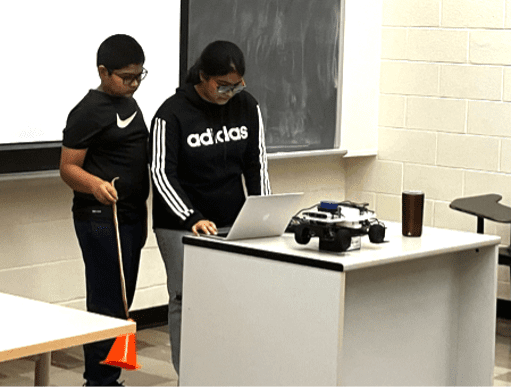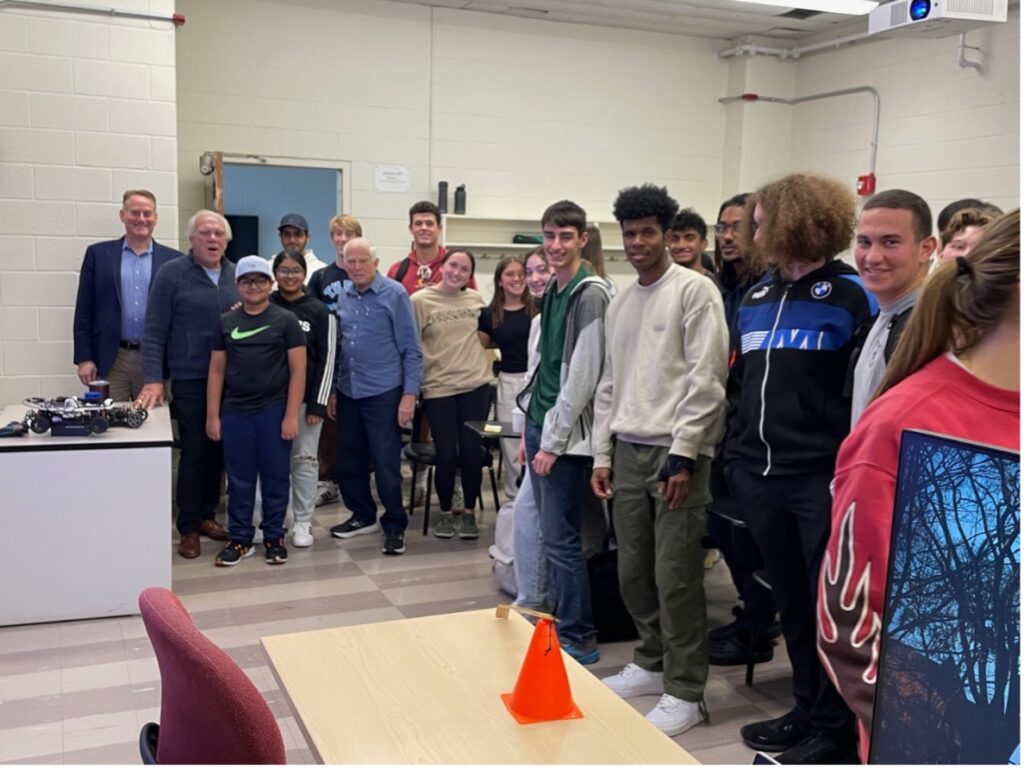
Autonomous Vehicles as a ‘Family Affair’
Adrita and Soham Samanta bring RACECAR to Tufts University
Autonomous vehicle technology will drastically change our world, but when? Full of promise but fraught with controversy, perhaps it really belongs to the next generation. If that is true, a teenage sister and brother team in Boston is ready to take ownership.
Adrita Samanta and her younger sibling Soham got started a couple of years ago, assembling a small robotic vehicle, called RACECAR*, as part of MIT’s Beaver Works Summer Institute (BWSI). Building on that effort, and expanding their skills, Adrita and Soham developed their own operational software for RACECAR’s onboard computer. The software takes input from advanced sensors, then, in response to human direction, makes decisions that drive electronic commands controlling the car.
The pair advanced their autonomous vehicle expertise to the point where they have served as guest lecturers – at the college level.
Presenting at Tufts
In October, the Samantas brought their RACECAR to a Tufts University classroom, presenting and demonstrating during a session of ‘The Impact of Self-Driving Cars’. This interdisciplinary course examines the technologies, human-factors, key players, and far-reaching implications of autonomous vehicles.
Adrita’s presentation introduced the self-driving technologies in RACECAR, then got into some of the design details. This was followed by demonstrations, with Tufts students participating, of the RACECAR following a small orange pylon around the classroom.
Competence Not Always a Function of Age
“It was amazing to see how Adrita captured the complete attention of the Tufts students,” said Jim Sproul, a Tufts Guest Speaker who facilitated the Samantas’ participation in the class. “They quickly recognized that she was truly an expert in this facet of autonomous technology and were quite willing to learn from her, even though she was a lot younger. “
“RACECAR was the experience that first got me interested in robotics,” explained Adrita.” After that I began working in a Tufts University lab under the supervision of Prof. Jivko Sinapov. Now I am taking Math and Computer Science courses at Tufts while working on a Cloud Computing project in Prof. Raja Sambasivan’s Tufts lab as an MIT PRIMES student.”
Preparing Students for Tomorrow’s World

Tufts students explore ‘The Impact of Self-Driving Cars’
“Our course ‘The Impact of Self-Driving Cars’ helps students understand this rapidly emerging technology and appreciate the powerful ways it will impact the future of their world,” said Hal Miller-Jacobs, one of the course instructors at Tufts. “It was so meaningful for our students to see young people interested in moving technology forward. We often only hear the ‘bad’ news about kids, so this experience was refreshing and encouraging for our future.”
Dr. James Intriligator, the other instructor, was equally enthusiastic. “It was great that Jim Sproul could bring the Samantas to visit our class as guest lecturers. The students were incredibly impressed with Adrita and Soham – their knowledge and passion were inspiring. At the end of the semester many listed the RACECAR visit as one of the class highlights. Beyond just RACECAR, our students were also extremely interested in the innovative STEM classes that Jim has enabled for greater Boston public schools.”
Some Background on RACECAR
RACECAR itself deserves some attention. There are two versions, (1) MIT RACECAR Model Nano and (2) RACECAR-Zero.
Model Nano is the high-powered version used by the Samanta’s. The kit of components, costing around $750, includes LIDAR and IR sensors, a battery, an NVIDIA GPU computer, and a chassis with flexible front-end steering. It is a sophisticated package capable of advanced self-driving functions, used during BWSI by selected high school students who first assemble, then program the robotic cars.
A lower kit cost was required to make the BWSI approach broadly available to middle and high school STEM programs. That was achieved with RACECAR-Zero, a kit that includes a Pi video camera, a Raspberry Pi Zero computer, disposable batteries, and a differential-steered chassis. With a total cost of around $125, RACECAR-Zero can be programmed to autonomously navigate a track with a variety of curves. “A shout out to Bob Cassels, an avid volunteer to the Beaver Works program and supporter of STEM education who made RACECAR-Zero a reality,” said Sproul.
STEM Education Really Can Be Exciting
“RACECAR has been a wonderful hands-on STEM education opportunity for Soham and me,” said Adrita. “Making design choices, discovering how components interact, and debugging problems, these are all great ways to learn. Then there is the reward of watching the car do what we wanted it to do.”
So yes, a couple of things are true. Autonomous vehicle technology really does work and STEM education really can be exciting. “I have been involved with RACECAR for over four years, and it always gets an enthusiastic response, ”shared Sproul. “It’s just a great may to teach STEM skills to middle school and high school students, helping them work together in small groups to create their own solutions to design challenges.”
* Rapid Autonomous Complex Environment Competing Ackermann steeRing

Recent Comments